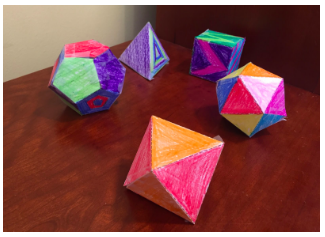Platonic Solids (Investigation)
The Platonic solids are five special 3D shapes. We will investigate what makes them special by creating them from their nets.
Start by printing these nets, then cut them out along the solid lines.
 |
 |
 |
| Click or tap to download each page | ||
Use crayons, pencils, or markers to colour them in however you like. Draw shapes and patterns on them - get creative!
When you're ready, fold them up along the dotted lines and use some tape to keep them together. They should look something like this:

Finished solids
Now that you have the solids, answer the following questions for each of them:
- What kind of shape are the faces?
- How many faces does the shape have?
- How many edges does the shape have?
- How many vertices does the shape have?
- How many edges meet at each vertex?
Write your answers in a table like this one:
| Face shape | Faces | Edges | Vertices | Edges meeting at vertex |
|---|---|---|---|---|
- Now pick any row of the table, add together the number of faces and the number of vertices, and subtract the number of edges. What number do you get?
- Can you see any other patterns in the numbers?
Each of these five shapes are named for the number of faces they have. The suffix "-hedron" means a solid shape with flat faces, and combining that with the right prefix will give you its name:
| Faces | Prefix | Name |
|---|---|---|
| 4 | tetra- | tetrahedron |
| 5 | penta- | pentahedron |
| 6 | hexa- | hexahedron |
| 7 | hepta- | heptahedron |
| 8 | octa- | octahedron |
| 9 | nona- | nonahedron |
| 10 | deca- | decahedron |
| 11 | hendeca- | hendecahedron |
| 12 | dodeca- | dodecahedron |
| 13 | triadeca- | triadecahedron |
| 14 | tessaradeca- | tessaradecahedron |
| 15 | pentedeca- | pentedecahedron |
| 16 | hexadeca- | hexadecahedron |
| 17 | heptadeca- | heptadecahedron |
| 18 | octodeca- | octodecahedron |
| 19 | enneadeca- | enneadecahedron |
| 20 | icosa- | icosahedron |
- Can you find the correct names for these five shapes?
- Can you make a pentahedron out of triangles?
- Can you make shapes like these using hexagon faces?
These "Platonic solids" are named after Plato, an ancient Greek philosopher who lived almost 2500 years ago. These shapes have been studied by philosophers and mathematicians in many different cultures across the world and all throughout history. What do you think makes them so special?
Other solids
There are shapes with many more faces, like this one:
 |
| Click or tap to download |
The name of this shape is a truncated icosahedron (even though it has 32 faces). You may have seen shapes like these on the football field! Try cutting this one out as well to investigate it further.
- How is this shape similar to the other platonic solids?
- How is it different?
- How is it related to an icosahedron?